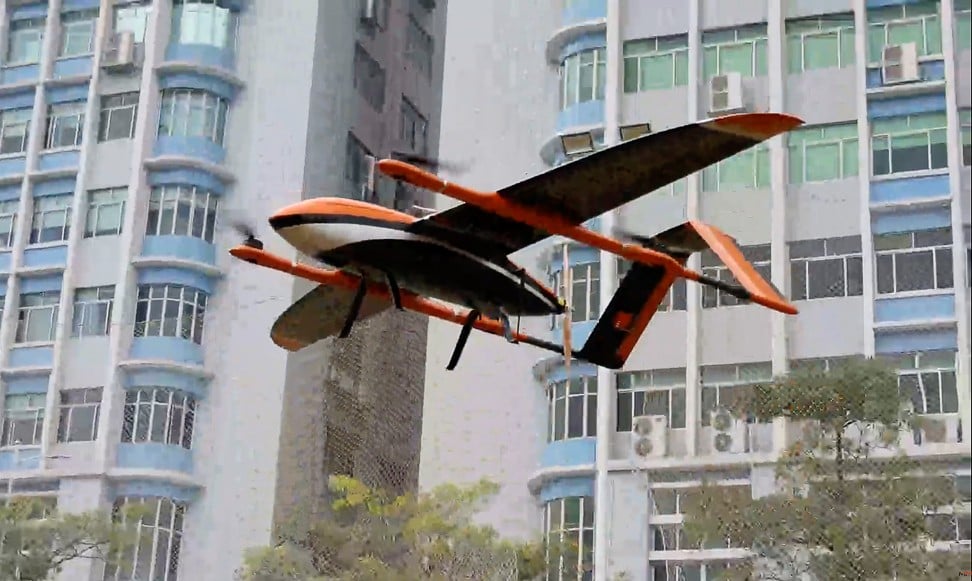
China adapts surveying, mapping, delivery drones to enforce world’s biggest quarantine and contain coronavirus outbreak
- Shenzhen Smart Drone UAV’s drones used in surveying, mapping can lift a maximum payload of 15kg
- Adaptation shows how outbreak has opened the door for innovative applications to emerge from existing tech
China’s government, in enforcing the world’s largest quarantine to contain the coronavirus outbreak, has adapted and co-opted industrial drones to help ensure that an estimated 50 million residents are kept at home and indoors across a dozen cities.
The software flying the drones made in Shenzhen is being rewritten to adapt their applications for disease detection and crowd management. The vehicles will use thermal sensors, high-definition zoom lenses, loudspeakers and chemical spray jets for disinfecting large areas, according to two makers of industrial drones.
“The coronavirus outbreak has changed the way people work and operate,” bolstering applications and autonomous equipment that reduce human contact, said Xie Jia, deputy general manager at Shenzhen Smart Drone UAV. The company’s drones are used in surveying, mapping and defence, with a logistics model that can lift a maximum payload of 15kg.
US report highlights reasons for military ban on DJI drones
The adaptation shows how the coronavirus epidemic, which has sickened at least 94,000 people worldwide with a death toll of more than 3,200, has opened the door for innovative applications to emerge from existing technology. China, where the global outbreak was first identified in January in Hubei’s provincial capital of Wuhan, is the epicentre of both the outbreak and the technological innovation.

For a glimpse at the transformation underway, look no further than Shenzhen, which is 15 minutes away from Hong Kong on the high-speed train. As many as 360 drone makers are based in Shenzhen, collectively supplying 70 per cent of the world’s civilian drones and 60 per cent of China’s industrial aerial vehicles, according to official data. The market for industrial drones may grow 42 per cent this year to 8.5 billion yuan (US$1.2 billion), according to a forecast by market research firm AskCI Consulting.
Shenzhen, known as China’s Silicon Valley, is already home to several of China’s technology leaders, including the world’s biggest 5G telecommunication equipment maker Huawei Technologies, the country’s largest games publisher and social media network Tencent Holdings, and the No 1 global maker of recreational drones DJI. More than 300 people have caught the virus in the southern Chinese metropolis.
“The coronavirus outbreak has led to a deeper understanding of the application of drones by society and government,” said Lu Zhihui, chairman of Shenzhen MicroMultiCopter Aero Technology, whose surveying and mapping drones can be geared with loudspeakers, thermal sensors, 40-times zoom lenses and flood lights to help enforce quarantines. “It’s an excellent catalyst for our company’s development that will fast-track our growth.”
DJI improves temperature-measuring drones with a simple cotton swab
MicroMultiCopter said has supplied more than 100 drones to local authorities in 11 Chinese cities since the outbreak led to citywide quarantines in late January, and is working with government agencies that include the police, transport department and local propaganda unit. Each drone can patrol a 10 square kilometre urban area in an hour, saving the work of more than 100 police officers in dozens of patrol cars, Lu said.
MicroMultiCopter plans to more than double its production to 5,000 units this year, from last year’s 2,000, as a result of new orders, Lu said, declining to divulge the catalogue price of each drone.

Both MicroMultiCopter and Smart Drone count government clients as one of their most important sources of income, with the sales making up about 30 per cent of their overall revenue.
Before the epidemic, MicroMultiCopter had supplied drones to police across the country for purposes that included covert surveillance, criminal arrests, and ensuring the safety of large public events.
Shenzhen has risen quickly to become China’s drone capital after its government set the industry as one of the fields with a development priority in 2013.
The most popular types of drones are those with megaphones that can broadcast propaganda messages and public health updates, as well as larger ones that can transport medical equipment to places where road traffic is blocked, said Xie of Smart Drone, which is already working with police in more than 20 cities and provinces.
Purchase the China AI Report 2020 brought to you by SCMP Research and enjoy a 20% discount (original price US$400). This 60-page all new intelligence report gives you first-hand insights and analysis into the latest industry developments and intelligence about China AI. Get exclusive access to our webinars for continuous learning, and interact with China AI executives in live Q&A. Offer valid until 31 March 2020.

